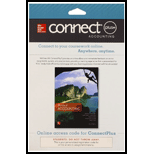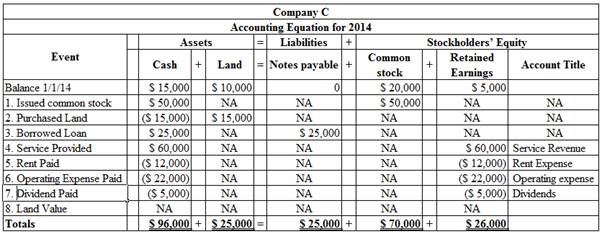
Concept explainers
a.
Record the eight events in the
a.
Explanation of Solution
The eight events are recorded using

Table (1)
b.
Prepare an income statement, statement of changes in equity, year-end
b.
Explanation of Solution
Income statement: Income statement is the financial statement of a company which shows all the revenues earned and expenses incurred by the company over a period of time.
Income statement for the 2014 is prepared as follows:
| Company C | |
| Income Statement | |
| For the Year Ended December 31, 2014 | |
| Particulars | Amount ($) |
| Service Revenue | 60,000 |
| Utilities Expense | (12,000) |
| Operating Expense | (22,000) |
| Net Income | $26,000 |
Table (2)
Statement of changes in stockholders' equity: Statement of changes in stockholders' equity records the changes in the owners’ equity during the end of an accounting period by explaining about the increase or decrease in the capital reserves of shares.
Statement of changes in equity for the 2014 is prepared is as follows:
| Company C | ||
| Statement of Changes in | ||
| For the Year Ended December 31, 2014 | ||
| Particulars | Amount ($) | Amount ($) |
| Beginning Common Stock | 20,000 | |
| Add: Common Stock Issued | 50,000 | |
| Ending Common Stock | 70,000 | |
| Beginning | 5,000 | |
| Add: Net Income | 26,000 | |
| Less: Dividends | (5,000) | |
| Ending Retained Earnings | 26,000 | |
| Total Stockholders’ Equity | $96,000 | |
Table (3)
Balance sheet: Balance Sheet is one of the financial statements that summarize the assets, the liabilities, and the Shareholder’s equity of a company at a given date. It is also known as the statement of financial status of the business.
Balance sheet for the 2014 is prepared as follows:
| Company C | ||
| Balance Sheet | ||
| As of December 31, 2014 | ||
| Particulars | Amount ($) | Amount ($) |
| Assets: | ||
| Cash | 96,000 | |
| Land | 25,000 | |
| Total Assets | $121,000 | |
| Liabilities: | ||
| Notes Payable | 25,000 | |
| Total Liabilities | 25,000 | |
| Stockholders’ Equity: | ||
| Common Stock | 70,000 | |
| Retained Earnings | 26,000 | |
| Total Stockholders’ Equity | 96,000 | |
| Total Liabilities and Stockholders’ Equity | $121,000 | |
Table (4)
Statement of cash flows: Statement of cash flows is one among the financial statement of a Company statement that shows aggregate data of all
Statement of cash flows for the 2014 is prepared as follows:
| Company C | ||
| Statement of Cash Flows | ||
| For the Year Ended December 31, 2014 | ||
| Particulars | Amount ($) | Amount ($) |
| Cash Flows From Operating Activities: | ||
| Cash Receipts from Customers | 60,000 | |
| Cash Payment for Utilities Expense | (12,000) | |
| Cash Payments for Other Operating Expense | (22,000) | |
| Net Cash Flow from Operating Activities | 26,000 | |
| Cash Flows From Investing Activities: | ||
| Cash Paid to Purchase Land | (15,000) | |
| Net Cash Flow from Investing Activities | (15,000) | |
| Cash Flows From Financing Activities: | ||
| Cash Receipts from Stock Issue | 50,000 | |
| Cash Receipts from Loan | 25,000 | |
| Cash Payments for Dividends | (5,000) | |
| Net Cash Flow from Financing Activities | 70,000 | |
| Net Increase in Cash | 81,000 | |
| Add: Beginning Cash Balance | 15,000 | |
| Ending Cash Balance | $96,000 | |
Table (5)
c.
Ascertain the percentage of assets provided by the retained earnings and find out the amount of cash in the retained earnings account.
c.
Explanation of Solution
Retained earnings:
Retained earnings are the portion of earnings kept by the business for the purpose of reinvestments, payment of debts, or for future growth.
Calculate the percentage of assets provided by retained earnings:
Retained earnings are used to purchase assets or to pay liabilities. Therefore, the amount of cash in the retained earnings accounts cannot be determined directly.
Therefore, the percentage of assets provided by retained earnings is 21.5%.
Want to see more full solutions like this?
Chapter 1 Solutions
SURVEY OF ACCOUNTING-ACCESS
- Can you help me solve this general accounting question using the correct accounting procedures?arrow_forwardGalaxy Enterprises reports its accounts receivable on the balance sheet. The gross receivable balance is $75,000, and the allowance for uncollectible accounts is estimated at 12% of gross receivables. At what amount will accounts receivable be reported on the balance sheet?arrow_forwardHi expert please given correct answer with accountingarrow_forward
- Can you demonstrate the proper approach for solving this financial accounting question with valid techniques?arrow_forwardAstoria Manufacturing's May 1, 2022, beginning work in process was 1,245 units. During May Astoria put into production an additional 3,675 units were put into production. At the end of May, all units were completed except for 820 units. Use this information to determine the number of units completed.arrow_forwardCan you help me solve this general accounting question using valid accounting techniques?arrow_forward
- I need guidance with this financial accounting problem using the right financial principles.arrow_forwardI need help with this financial accounting question using the proper accounting approach.arrow_forwardNova Consulting estimates its consultants will work 25,000 direct labor hours per year. The company's projected total indirect costs are $320,000. The direct labor rate is $95 per hour. The company uses direct labor hours as the allocation base for indirect costs. If Nova performs a job requiring 32 hours of direct labor, what is the total job cost?arrow_forward

 AccountingAccountingISBN:9781337272094Author:WARREN, Carl S., Reeve, James M., Duchac, Jonathan E.Publisher:Cengage Learning,
AccountingAccountingISBN:9781337272094Author:WARREN, Carl S., Reeve, James M., Duchac, Jonathan E.Publisher:Cengage Learning, Accounting Information SystemsAccountingISBN:9781337619202Author:Hall, James A.Publisher:Cengage Learning,
Accounting Information SystemsAccountingISBN:9781337619202Author:Hall, James A.Publisher:Cengage Learning, Horngren's Cost Accounting: A Managerial Emphasis...AccountingISBN:9780134475585Author:Srikant M. Datar, Madhav V. RajanPublisher:PEARSON
Horngren's Cost Accounting: A Managerial Emphasis...AccountingISBN:9780134475585Author:Srikant M. Datar, Madhav V. RajanPublisher:PEARSON Intermediate AccountingAccountingISBN:9781259722660Author:J. David Spiceland, Mark W. Nelson, Wayne M ThomasPublisher:McGraw-Hill Education
Intermediate AccountingAccountingISBN:9781259722660Author:J. David Spiceland, Mark W. Nelson, Wayne M ThomasPublisher:McGraw-Hill Education Financial and Managerial AccountingAccountingISBN:9781259726705Author:John J Wild, Ken W. Shaw, Barbara Chiappetta Fundamental Accounting PrinciplesPublisher:McGraw-Hill Education
Financial and Managerial AccountingAccountingISBN:9781259726705Author:John J Wild, Ken W. Shaw, Barbara Chiappetta Fundamental Accounting PrinciplesPublisher:McGraw-Hill Education





